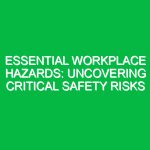Understanding Hazard Symbols for Chemicals
In our increasingly chemical-driven world, understanding hazard symbols for chemicals has become essential for safeguarding health and Safety. These symbols serve as visual warnings, conveying critical information about the potential dangers associated with various substances. Whether in industrial environments or households, these symbols are pivotal in ensuring that individuals handle chemicals safely and responsibly.
The relevance of hazard symbols extends beyond mere recognition; they are integral to the Health, Safety, and Environment (HSE) domain. With effective communication of hazardous properties, these symbols help prevent accidents, injuries, and environmental damage. This article will delve into the key aspects of hazard symbols for chemicals, their significance, regulations surrounding them, and actionable insights for ensuring Safety.
The Importance of Hazard Symbols in Health, Safety, and Environment (HSE)
Hazard symbols for chemicals are not just a series of images; they are essential components of safety signage that inform users about the type of Hazards they may encounter. These symbols convey critical information aimed at preventing exposure to harmful substances and ensuring that appropriate Safety Measures are in place.
When chemicals are mishandled, the consequences can be dire. For instance, a worker in a manufacturing plant may encounter corrosive substances without adequate warning, leading to severe injuries. Similarly, improper disposal of hazardous waste can result in environmental contamination. Therefore, hazard symbols play a vital role in risk management by providing immediate visual cues that can help avert such incidents.
Key Hazard Symbols and Their Meanings
Understanding the specific hazard symbols for chemicals is crucial for recognizing the risks associated with different substances. Below are some of the most commonly encountered symbols and their meanings:
1. Explosive (Exclamation Mark)
This symbol indicates that a chemical can explode under certain conditions, such as heat, pressure, or impact. Explosive materials are often found in industries that utilize pyrotechnics or chemicals that react violently.
2. Flame
The flame symbol denotes a flammable substance that can ignite easily. This symbol is critical in environments where flammable materials are present, such as laboratories and chemical storage areas.
3. Corrosive (Test Tube and Hand)
This symbol warns of substances that can cause severe skin Burns or eye damage. Corrosives can also damage metals, making it essential to handle them with care.
4. Gas Cylinder
This symbol indicates gases under pressure, which can pose explosion risks if not handled correctly. Understanding this hazard is crucial for professionals working with compressed gases in various industries.
5. Health Hazard
The health hazard symbol signifies substances that may cause serious health Effects, including carcinogenic properties or reproductive toxicity. Awareness of this symbol is vital for workers in healthcare and chemical industries.
6. Environmental Hazard (Tree and Fish)
This symbol highlights chemicals that pose risks to the environment, such as aquatic toxicity. Recognizing this hazard can drive better practices in waste disposal and chemical usage.
Real-life Implications of Hazard Symbols
To illustrate the importance of hazard symbols for chemicals, consider the case of a manufacturing facility that failed to properly label its chemical storage. In this hypothetical scenario, a worker inadvertently mixed a corrosive agent with a flammable solvent, resulting in an explosion that caused injuries and extensive property damage. Had the chemicals been clearly labeled with the appropriate hazard symbols, the worker might have recognized the dangers and taken Precautions to prevent the accident.
Another example can be found in the agricultural sector, where pesticides are commonly used. Farmers must understand the hazard symbols on pesticide labels to ensure safe application and storage. Misinterpretation or ignorance of these symbols could lead to health risks for the farmers and contamination of nearby water sources.
Regulations and Standards Governing Hazard Symbols
The regulation of hazard symbols for chemicals is governed by various international and local standards. One of the most significant frameworks is the Globally Harmonized System of Classification and Labelling of Chemicals (GHS). This system standardizes the classification and labeling of chemicals, ensuring that hazard symbols are universally recognized.
In addition to GHS, countries have their own Regulations. In the United States, for example, the Occupational Safety and Health Administration (OSHA) enforces standards that require proper labeling and safety data sheets for hazardous chemicals. In Europe, the European Chemicals Agency (ECHA) oversees compliance with the Registration, Evaluation, Authorisation, and Restriction of Chemicals (REACH) regulation.
These regulations not only mandate the use of hazard symbols but also require Training for employees on how to interpret and respond to these warnings. Compliance with these standards is crucial in promoting a culture of safety within organizations.
Best Practices for Handling Hazard Symbols
To effectively protect health and safety, individuals and organizations must implement Best Practices when dealing with hazard symbols for chemicals. Here are some actionable guidelines:
1. Training and Awareness
Invest in comprehensive training programs for employees to ensure they understand hazard symbols and their meanings. Regular workshops and safety drills can reinforce this knowledge.
2. Proper Labeling
Ensure that all chemical containers are clearly labeled with the appropriate hazard symbols. Consistent labeling practices help prevent misunderstandings and promote safe handling.
3. Safety Data Sheets (SDS)
Maintain up-to-date Safety Data Sheets for all chemicals. These documents provide detailed information on the Hazards, handling Procedures, and emergency measures related to each chemical.
4. Emergency Response Plans
Develop and communicate clear emergency response plans that include specific actions to take in the event of a chemical spill or exposure. Regular drills can help prepare employees for real-life scenarios.
5. Personal Protective Equipment (PPE)
Encourage the use of appropriate Personal Protective Equipment when handling hazardous chemicals. This could include gloves, goggles, face shields, and respirators, depending on the level of risk.
Conclusion
Hazard symbols for chemicals are not merely decorative; they are essential tools for protecting health, safety, and the environment. By understanding and recognizing these symbols, individuals and organizations can mitigate risks associated with hazardous substances.
The significance of hazard symbols in the HSE domain cannot be overstated. They foster a culture of safety that not only protects workers but also preserves the environment. As we continue to navigate a world filled with chemicals, embracing the principles of Hazard Communication will be instrumental in ensuring a safer future for all.
As you ponder the implications of hazard symbols for chemicals, consider how you can contribute to safer practices in your environment. Whether you’re a worker, employer, or consumer, staying informed and proactive is key to fostering a safer world.


